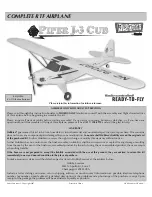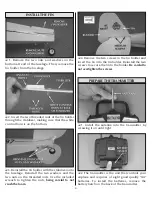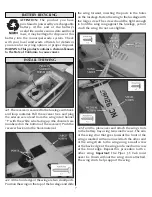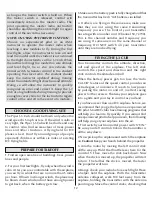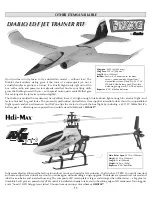
12
as long as the trainer switch is held on. When
the trainer switch is released, control will
immediately return to the master radio. The
pilot operating the master radio (instructor)
should be alert during the entire fl ight to regain
control of the aircraft as necessary.
NOTES ON USING THE TRAINER FUNCTION:
Choose an experienced pilot or an AMA
instructor to operate the master radio when
teaching a new modeler to fl y. During the fi rst
few fl ights, allow the instructor to take off and
land the model until the student is accustomed
to the fl ight characteristics of the J-3 Cub. When
the instructor brings the model to a safe altitude
and level fl ight, he or she can activate the
trainer switch to transfer control to the student
operating the slave radio. The student should
keep the instructor updated during training
about the intended fl ight direction and altitude.
Doing so will allow the instructor to quickly
recognize an error and correct it. Keep the J-3
Cub at a high altitude during training to provide
enough recovery time for the instructor to regain
control of the aircraft in the event of a mistake.
CHOOSE A GOOD FLYING SITE
The Piper J-3 Cub should be fl own only when the
wind speed is 5 mph or less. If the wind is calm or
very light, the Piper J-3 Cub will be docile and easy
to control. Also, fi nd an area clear of trees, power
lines and other structures. A fl ying fi eld for R/C
planes is best. Don’t fl y around groups of people,
especially children or within six miles of existing
R/C fl ying fi elds.
PREPARE FOR TAKEOFF
1. Find an open area free of buildings, trees, power
lines and people.
2. For your fi rst few fl ights, fl y only when the wind is
calm. After you are comfortable with the airplane,
you can fl y in winds that are no more than 5 miles
per hour. If fl own in stronger winds, the plane may
be blown down wind and not have enough power
to get back, when the battery gets low.
3. Make sure the battery pack is fully charged and that
the transmitter has fresh “AA” batteries installed.
4. If others are fl ying in the same area, make sure
that they are not using the same transmitting
frequency you are. The front of your transmitter
has a tag with a number on it (Channel 50, 72.790).
This is the channel number and frequency you
are using. If someone is on the same channel or
frequency, DO NOT switch on your transmitter
until they are fi nished fl ying.
FLYING THE J-3 CUB
Your transmitter controls the altitude, direction,
roll and speed of the airplane. The left stick
controls the speed and direction and the right
stick controls the altitude and roll.
When the battery power gets too low, the “Auto
Cut-Off” feature of the speed control provides an
extra degree of insurance. It reacts to low power
by pulsing the motor on and off, in effect saving
power for the receiver. That way your airplane goes
into a glide and you stay in control as you land.
If you have never fl own an R/C airplane before, we
recommend that you get help from an experienced
R/C pilot. Most R/C clubs have training programs that
will help you learn to fl y quickly. If you cannot fi nd
an experienced pilot to help you learn, the following
will help you get your airplane into the air.
1. First switch your transmitter power switch “ON.”
Be sure your left control stick on the transmitter is
all the way down.
2. Now pick up the airplane and switch the airplane
on.
Caution:
Keep your hands behind the propeller.
3. Arm the motor by moving the left control stick
all the way up. Hold the throttle lever here for the
count of 5. Then, move the stick back down. Now
when the stick is moved up, the propeller will start
to turn. The farther the stick is moved, the faster
the propeller will turn.
4. Range check your radio before each fl ight. Have
a helper hold the airplane. With the transmitter
antenna collapsed, walk 100 feet away from the
airplane, holding the transmitter with the antenna
pointing up. Move the control sticks, checking that

